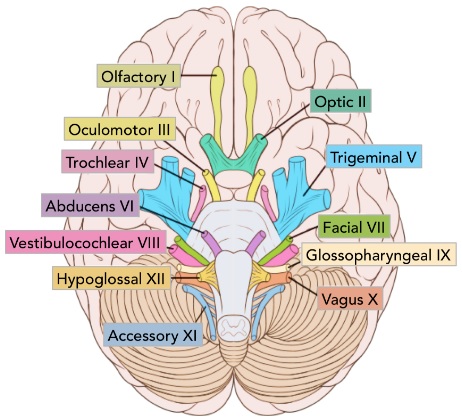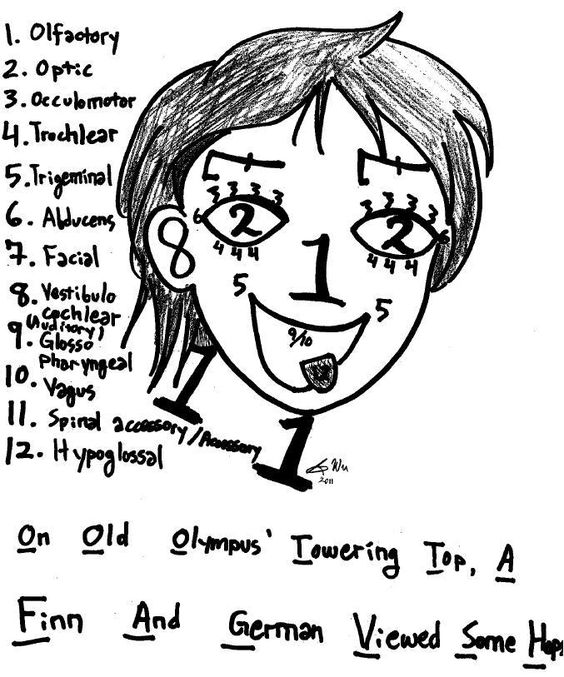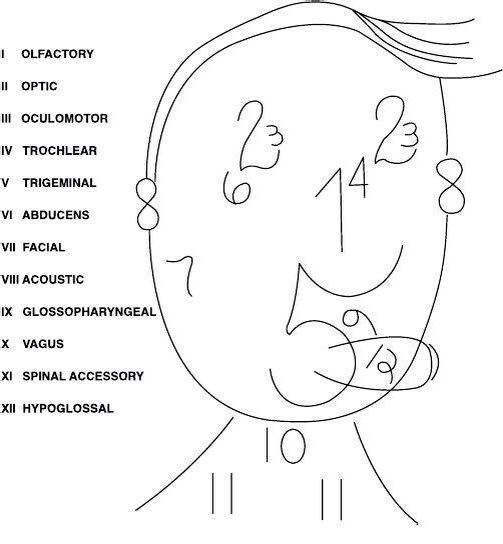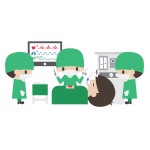The Head and Neck Anatomy is one of the most important topics when it comes to studying the 2nd year human anatomy at medical school. It deals with structures primarily involving the head and neck region of the body. It is highly recommended that you master this region if you really wish to perform well both in the exams and as a future clinician. This article is dedicated to sharing cranial nerves mnemonics so that you can easily remember things like: the names of the 12 cranial nerves (in exact sequence/order) and also types of cranial nerves (their modality: sensory, motor or both) and their functions as well. 🙂
But before that we jump to the cranial nerves mnemonics, let’s take a look at a few important things regarding the Cranial Nerves:
What are Cranial Nerves?
For starters, there are 12 pairs of cranial nerves that arise directly from the brain and brainstem (while on the other hand, the spinal nerves emerge from the spinal cord and its segments). To further your insight, 10 of the 12 cranial nerves originate from the brainstem and only two, the Olfactory Nerve (CN I) and the Optic Nerve (CN II) originate from the Cerebrum of the brain. Each cranial nerve has its own specific function which can be well understood by looking into its modality and the area that it is supplying. For the sake of simplicity, the cranial nerves transmit information from different part of the body, mainly from the regions of the Head and Neck, to the brain.
Here’s a cranial nerves summary table with fast facts such as:
- Number (denoted by CN, for Cranial Nerve and Roman numeric I to XII)
- Cranial Nerve Names
- Modality (Sensory, Motor or Both/Mixed)
- Origin
- Exit Route
- Function of the Cranial Nerves
Cranial Nerves Summary Table |
|||||
| Number of the Cranial Nerve | Name of the Cranial Nerve | Modality | Origin | Exit Route | Function of the Cranial Nerve |
| 1: CN-I | Olfactory Nerve | Sensory | Olfactory Lobe | Cribriform Plate | Smell |
| 2: CN-II | Optic Nerve | Sensory | Optic Lobe | Optic Canal | Vision |
| 3: CN-III | Occulmotor Nerve | Motor | Floor of the Midbrain | Superior Orbital Fissure | Helps in moving the eyelid & eyeball and adjusts the pupil and lens of the eye |
| 4: CN-IV | Trochlear Nerve | Motor | From the junction between the optic lobe and cerebellum | Superior Orbital Fissure | Moves the eyeballs |
| 5: CN-V | Trigeminal Nerve (Branches: Ophthalmic, Maxillary, and Mandibular) | Both | Side of the Medulla Oblongata | i.Ophthalmic: Superior orbital fissure ii.Maxillary: Foramen Rotundum iii.Mandibular: Foramen Ovale |
Controls facial muscles and actions including chewing and facial sensations |
| 6: CN-VI | Abducens Nerve | Motor | Ventral side of the Medulla | Superior Orbital Fissure | Moves the eyeballs |
| 7: CN-VII | Facial Nerve | Both | Lateral side of the Medulla | Internal Acoustic Meatus | Responsible for taste, tears (lacrimation), salivation and facial expressions |
| 8: CN-VIII | Vestibulocochlear Nerve | Sensory | Floor of the Medulla | Internal Acoustic Meatus | Hearing and balance |
| 9: CN-IX | Glassopharyngeal Nerve | Both | Side of the Medulla | Jugular Foramen | Controls swallowing, saliva, taste |
| 10: CN-X | Vagus Nerve | Both | Sides of the Medulla, from the Vagus Ganglion | Jugular Foramen | Brings about control over the Parasympathetic Nervous System e.g. smooth muscles of the GI tract |
| 11: CN-XI | Accessory Nerve | Motor | Sides of the Medulla and Spinal Cord | Jugular Foramen | Head and shoulder movement and assists in swallowing |
| 12: CN-XII | Hypoglossal Nerve | Motor | Ventral Side of the Medulla | Hypoglossal Canal | Controls tongue muscles and swallowing |
Origin of the Cranial Nerves
Below is an illustration depicting the origin of Cranial Nerves from different areas of the brain:

Cranial Nerves Mnemonics
Alright, we hope that with the above-mentioned discussion, you must now have developed a sound understanding of the cranial nerves (for more, please refer to standard textbooks). In this part of our blog post, we’ll be discussing the cranial nerves mnemonics so that you can easily remember the order of cranial nerves (from cranial nerve I to XII) and modality/function of cranial nerves.
Cranial Nerves Mnemonics for Remembering Order of CN
Below are the cranial nerves mnemonics to help you remember the order of cranial nerves from CN I (olfactory nerve) to CN XII (hypoglossal nerve):
CLEAN MNEMONICS
On old Olympus’ towering top a Finn and German viewed some hops
Ooh, ooh, ooh to touch and feel very good velvet. Such heaven!
Oh, Oh, Oh to take a Family vacation! Go vegas and Hardees.
DIRTY MNEMONIC
Oh, oh, oh, to touch and feel a girl’s vagina. Ah, heaven. 😀
MNEMONIC KEY:
Focus on the first alphabet as “key” to the above-mentioned mnemonics:
O: Olfactory nerve (CN I)
O: Optic nerve (CN II)
O: Oculomotor nerve (CN III)
T: Trochlear nerve (CN IV)
T: Trigeminal nerve (CN V)
A: Abducens nerve (CN VI)
F: Facial nerve (CN VII)
A: Auditory (or vestibulocochlear) nerve (CN VIII)
G: Glossopharyngeal nerve (CN IX)
V: Vagus nerve (CN X)
S: Spinal accessory nerve (CN XI)
H: Hypoglossal nerve (CN XII)
Cranial Nerves Harry Potter Mnemonic
Here’s a special Harry Potter themed mnemonic to help you memorize order of cranial nerves in a fun way: 🙂

*RECOMMENDED MNEMONICS*
Drugs that Cause Gynecomastia Mnemonic
Drugs that Cause Hepatitis Mnemonics (Drug-Induced Hepatitis)
Seizure Differential Diagnosis Mnemonics
Cranial Nerves Sensory Or Motor Mnemonic
Below are cranial nerves mnemonics to help you easily remember which cranial nerves are sensory, motor, or mixed/both (modality/functions of CN I to CN XII).
CLEAN MNEMONIC
Some say marry money but my brother says big brains matter more.
DIRTY MNEMONIC
Some say money matters but my brother says big boobs matter more. 😀
MNEMONIC KEY:
S: Sensory (Olfactory nerve – CN I)
S: Sensory (Optic nerve – CN II)
M: Motor (Trochlear nerve – CN IV)
B: Both (Trigeminal nerve – CN V)
M: Motor (Abducens nerve – CN VI)
B: Both (Facial nerve – CN VII)
S: Sensory (Vestibulocochlear nerve – CN VIII)
B: Both (Glossopharyngeal nerve CN IX)
B: Both (Vagus nerve – CN X)
M: Motor (Accessory nerve – CN XI)
M: Motor (Hypoglossal nerve – CN XII)
And here’s a picture (well, a little creepy, I know! 😀 ) showing functions of the cranial nerves:

And this old one too:

That’s it folks! We hope that you find these mnemonics useful in memorizing key facts about the cranial nerves. 🙂
Happy learning people! 🙂
Got more interesting or dirtier cranial nerves mnemonics? 😀 Hits us by commenting below. 🙂

![Cranial Nerves Mnemonics [Clean, Dirty & Easy-to-Remember] Cranial Nerves Mnemonics](https://www.medicosrepublic.com/wp-content/uploads/2017/10/Cranial-Nerves-Mnemonics-Clean-Dirty-Easy-to-Remember-696x365.jpg)



![Carcinoid Syndrome Mnemonic [Easy-to-memorize] Carcinoid Syndrome Mnemonic](https://www.medicosrepublic.com/wp-content/uploads/2024/08/Carcinoid-Syndrome-Mnemonic-Easy-to-memorize-218x150.jpg)

![Stages of Neurocysticercosis Mnemonic [Vegans Can’t Get Neurocysticercosis] Stages of Neurocysticercosis Mnemonic](https://www.medicosrepublic.com/wp-content/uploads/2023/08/Stages-of-Neurocysticercosis-Mnemonic-Vegans-Cant-Get-Neurocysticercosis-1-218x150.jpg)
![UWorld / UEarth MCAT Question Bank PDF Free Download [Direct Link]](https://www.medicosrepublic.com/wp-content/uploads/2023/01/UWorld-UEarth-MCAT-Question-Bank-PDF-Free-Download-150x150.jpg)
![Pharmacotherapy: A Pathophysiologic Approach 11th Edition PDF Free Download [Direct Link] Pharmacotherapy A Pathophysiologic Approach 11th Edition PDF](https://www.medicosrepublic.com/wp-content/uploads/2022/05/Pharmacotherapy-A-Pathophysiologic-Approach-11th-Edition-PDF-Free-Download-150x150.jpg)
![Mader’s Reptile and Amphibian Medicine and Surgery 3rd Edition PDF Free Download [Direct Link] Mader's Reptile and Amphibian Medicine and Surgery 3rd Edition PDF](https://www.medicosrepublic.com/wp-content/uploads/2022/05/Maders-Reptile-and-Amphibian-Medicine-and-Surgery-3rd-Edition-PDF-Free-Download-150x150.jpg)
![Clinical Neuroanatomy 29th Edition PDF Free Download [Direct Link] Clinical Neuroanatomy 29th Edition PDF](https://www.medicosrepublic.com/wp-content/uploads/2022/05/Clinical-Neuroanatomy-29th-Edition-PDF-Free-Download-150x150.jpg)
![Physiology at a Glance 4th Edition PDF Free Download [Direct Link] Physiology at a Glance 4th Edition PDF](https://www.medicosrepublic.com/wp-content/uploads/2019/02/Physiology-at-a-Glance-4th-Edition-PDF-Free-Download-150x150.jpg)
![Cellular and Molecular Immunology 10th Edition PDF Free Download [Direct Link] Cellular and Molecular Immunology E-Book 10th Edition PDF](https://www.medicosrepublic.com/wp-content/uploads/2022/08/Cellular-and-Molecular-Immunology-E-Book-10th-Edition-PDF-Free-Download-150x150.jpg)
![CURRENT Medical Diagnosis and Treatment 2020 59th Edition PDF Free Download [Direct Link] CURRENT Medical Diagnosis and Treatment 2020 59th Edition PDF](https://www.medicosrepublic.com/wp-content/uploads/2020/05/CURRENT-Medical-Diagnosis-and-Treatment-2020-59th-Edition-PDF-Free-Download-150x150.jpg)
![Nursing Cheat Sheets: 76 Cheat Sheets for Nursing Students PDF Free Download [Direct Link] Nursing Cheat Sheets 76 Cheat Sheets for Nursing Students PDF](https://www.medicosrepublic.com/wp-content/uploads/2023/01/Nursing-Cheat-Sheets-76-Cheat-Sheets-for-Nursing-Students-PDF-Free-Download-150x150.png)
![JVP Waveform Mnemonic [ASK ME] – Rapid Memorization JVP Waveform Mnemonic](https://www.medicosrepublic.com/wp-content/uploads/2023/08/JVP-Waveform-Mnemonic-ASK-ME-150x150.jpg)
![Ryan & Sherris Medical Microbiology 8th Edition PDF Free Download [Direct Link] Ryan & Sherris Medical Microbiology 8th Edition PDF](https://www.medicosrepublic.com/wp-content/uploads/2022/05/Ryan-Sherris-Medical-Microbiology-8th-Edition-PDF-Free-Download-150x150.jpg)





Helpful to remember…